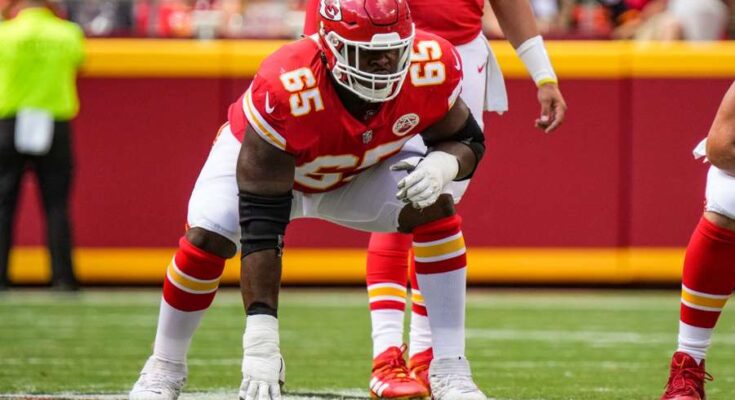VFL Trey Smith is now the highest-paid guard in the NFL after agreeing to a new deal with the Chiefs.
Trey Smith, the star guard for the Kansas City Chiefs, has cemented his status atop the NFL’s interior line hierarchy by finalizing a record-breaking long‑term contract with Kansas City. After playing the 2025 season on a one‑year franchise tag worth approximately $23.4 million, Smith and the Chiefs came to an agreement on a four‑year extension worth roughly $94 million with $70 million guaranteed. In doing so, Smith became the highest‑paid offensive guard in league history in terms of total value, average annual salary of about $23.5 million, and guaranteed money—resetting the guard market by a significant margin.
Smith’s journey to that elite level began when the Chiefs placed their non‑exclusive franchise tag on him in early March 2025, guaranteeing him a one‑year fully guaranteed salary of $23.4 million. Because the tag amount for guards is based on the upper echelon of all offensive linemen (including tackles), this elevated Smith’s status above all other guards in that contract year. The tag effectively made him the top‑paid guard for the season, and it set the stage for the eventual long‑term deal.
Negotiations began shortly after the cap space became available in late February when the Chiefs traded veteran guard Joe Thuney to the Chicago Bears for a 2026 fourth‑round pick, freeing up roughly $16 million in cap room. Smith’s side and Chiefs management, led by GM Brett Veach and coach Andy Reid, worked through the spring and early summer to reach an agreement. The two sides worked under the Bundesliga (league) deadline of July 15, 4 p.m. ET, to avoid locking Smith into the tag for the full season. They eventually reached a deal hours before the deadline—a hallmark example of intensive deadline‑driven negotiation
Under the terms of the extension, Smith received $70 million in guarantees—by far the most ever provided to any NFL guard. The deal includes a $17 million signing bonus and structures to guarantee his third year fully by the third day of the 2026 league year. About 75 percent of his total earnings are guaranteed, which is remarkable even by interior line standards. The average annual value at $23.5 million per year eclipses the previous record held by Landon Dickerson.(SI)
What sets this contract apart is not just the numbers but the method by which it reflects evolving market value. Prior to Smith’s extension, Philadelphia’s Landon Dickerson held the top guard contract at four years and $84 million, while Carolina’s Robert Hunt secured five years and $100 million with $63 million guaranteed. Smith’s deal surpasses both in AAV and guarantee, signifying a market reset and the Chiefs’ intention to keep their offensive line intact during Mahomes’ prime.
Smith’s on‑field resume supports the financial commitment. A sixth‑round pick in 2021, he immediately claimed the starting right guard job and has rarely missed a start in his career. He started all 17 regular‑season games and three playoff games during his rookie year, earning a spot on the PFWA All‑Rookie Team. He has since started over 80 career games and has anchored the line in two Super Bowl victories (LVII and LVIII). He was also selected to his first Pro Bowl in the 2024 season.
The Chiefs’ urgency to lock him in also stems from their desire to revamp the unit after the Super Bowl LIX loss, a game in which Patrick Mahomes was sacked six times. That exposed vulnerabilities led Kansas City to rebuild around Smith, center Creed Humphrey (who earlier signed a four‑year, $72 million extension), right tackle Jawaan Taylor, left tackle Jaylon Moore, and first‑round pick Josh Simmons. Smith’s new contract solidified a core that the team sees as central to future offensive success.(SI)
From Smith’s perspective, the deal provided long‑term security and allowed him to remain with a franchise where he has worn two rings, played alongside All‑Pro peers like Humphrey and enjoyed mutual trust with Mahomes and Reid. At age 26, signing a contract that extends through the 2028 season gives him a stable platform to continue building his career—and potentially cash in further if his play continues to ascend.
Some pundits and fans questioned whether investing heavily at guard made sense given positional value—Rex Thuney, an All‑Pro guard, departed in the offseason—but the Chiefs clearly chose to prioritize continuity for the interior line and long‑term investment in a young player who had already proven elite level performance.
Taken together, Smith’s new contract not only redefines the financial expectations for the guard position, but also represents Kansas City’s strategic vision heading into the next phase of the Mahomes era. It provides immediate cap certainty, ensures protection stability, and reinforces the Chiefs’ offensive identity built around elite interior line play. Smith now stands atop the guard market with a deal that is both historically significant and strategically smart for both player and franchise.
The significance of Smith’s deal extends beyond just dollars. It signals to the rest of the league that guard play—especially at the elite level—is increasingly being valued more heavily in salary structures. And for Kansas City, it represents a bet on long-term cohesion in an offense that has delivered three Super Bowl titles in four seasons. With Smith anchoring the right side, Creed Humphrey at center, and top talent all along the line, the Chiefs have bolstered arguably the league’s most important unit—protecting Patrick Mahomes.
In conclusion, Trey Smith’s contract with the Chiefs marks a turning point in NFL guard compensation. From franchise‑tag leverage to a league‑leading $94 million extension, Smith transitioned from the highest paid guard for one season to the highest‑paid ever in multiple respects. Backed by elite performance, organizational belief, and strategic timing, the deal anchors both his future and the Chiefs’ offensive line core well into the next era.



